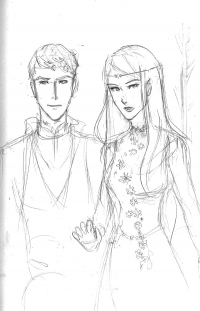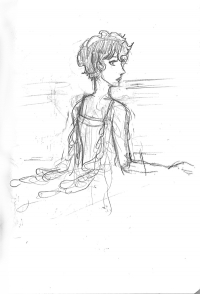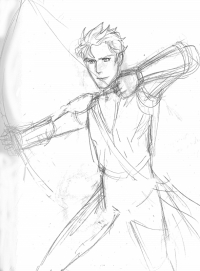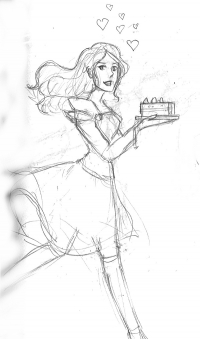“What if” Sketches
Edmund and Selva if they were raised differently and hung around more elves?
Elisa dipping in the water in the middle of a ritual. This image didn’t scan well enough to translate the elements on the back of her dress which float on the water’s surface like wings :>
Edmund if he were allowed to take on some different weapons. The bow the hunters use is not this elegant. This is probably borrowed from somewhere.
Poor Elanore hasn’t shown up in a while but if she could, she’d be prancing around baking, carrying, and eating strawberry cakes. Hopefully she doesn’t prance too hard. That usually leads to smashed cakes >_>
Question and Answer Time
Orchidus wrote: Oh, and I would definitely be interested in some author’s notes about halflings, if possible. How are they perceived by others? Do they have a tendency of inheriting magic from their parents, etc.?
Here’s what I have put together thus far with such an open prompt. Feel free to ask me more stuff in the comments. I have no problems answering general beliefs/specific cultural beliefs as long as you don’t ask me about specific characters (unless I already explained it in a forgotten chapter).
The term “halfling” is corrupted and imprecise.
1. a multiracial individual, usually with either elven or human ancestry. Most common reference is to those of mixed elf-human ancestry.
2. A creature that can via shapeshifting assume a bipedal appearance and one other form. Usually this form is dictated by ancestry.
3. Less commonly used as an insult, generally meaning “half a person.”
Definition 1 is the most generic usage of the term. Most of the time you see Definition 2 commonly referred to by the wolves. Definition 3 suggests “halfling” is not viewed in a positive manner by others, particularly humans. But “halfling” can also be used in a derogatory fashion between varying halfling types. For example, the wolves really hate/find the bears annoying and might comment “such a bear halfling,” as if to imply some kind of incompetence. I’m not sure why the wolves find the bears so offensive other than they probably resent that much power being present in such an otherwise (useless) creature.
In general, it is not “a positive” to be a halfling and many modern halflings are shy about expressing their non-bipedal forms. (I see this as an extension of many Western and Asian folk-stories whereby a lot of creatures are always trying to become human! )
Some key notes about Halflings and Shapechanging. These things are not equivalent!
- Being a halfling (mixed ancestry) doesn’t guarantee you can shapeshift.
- Shapechanging can be inherited. If it is an inherited trait, it follows many rules established with our modern genetics, hence, you cannot become something that didn’t exist in your ancestry short of acquiring an outside magical power. Also, shapechanging can lie dormant or lapse. It is not a “dominant” trait… in fact, the expression of it is selective. But it can be “triggered.” Example: Conn.
- Several characters can have more than one lineage but the belief is that you keep/transform into only one form over your lifetime. Selva is a likely example. She has the blood of many but cannot or will not change into anything except a wolf.
- Being a shapeshifter doesn’t mean you are necessarily a halfling. In theory, magic can allow you to break the “laws of nature” and change forms.
Shapechanging/shifting and magic
- The ability to shift can exist minus magical powers. Shapechanging can be simply a form of expression that is a kind of transformation between natural states. Think of it in most cases, as a part of a continuum along which someone can exist — kind of like water becoming ice becoming vapor and reverting back to ice or water.
- Magical shapechanging exists. It is believed, however, that only halflings have this capability. (Meaning that the belief is you can’t violate the laws of nature and acquire more than one form unless you already are a halfling.)
- It is believed that the exceptions to this rule were using illusion magic and not truly changing appearances.
Key notes: Magic
- There is no consistent belief system about magic and what place it has in the world as well as how it really works. (I jokingly refer to it as the “light as wave/particle” conundrum for those who remember high-school physcis.)
- Can you pass it to your progeny? Yes, but the shape of it and expression can change.
- Does the ability to use it skip generations? Yes, sometimes many at a time.
- Must you be predisposed to express it? Varying beliefs present among different cultures /races represented in this story alongside individuals. Wolfram and the wolves must believe in “inheritance” of magic, otherwise Selva would not be so valuable to them.
- Objects and places also hold magic; how they interact with living beings with magic varies. The lake and the Wolfram “castle” are examples of two places that have magic by themselves.





That picture of yours, albeit slightly unintentionally, just had me whip up this dessert with Elanore in mind: http://semna16.webs.com/Wildberry_Pancakes.jpg
She’d definitely approve!